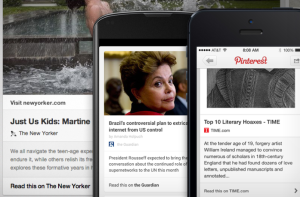What Pinterest’s New ‘Article Pins’
Mean For Brand Publishers
It’s been called the great unbundling of the news, post-industrial journalism, the “microchunking” of content, and atomisation. All these coinages express the same basic idea: that audiences are increasingly discovering, aggregating, remixing, and sharing content on social media sites.
What happens after the initial social media burst, though? At times, it seems to make content more ephemeral, traversing through the social ecosystem for a day or so, only to sputter out, left for search engines to unearth.
Pinterest, though, seems to be one exception, as the site’s structure of crafted boards give shared content a longer shelf life. Pinterest is often de-prioritized by publishers because it’s seen as more of an image-sharing site. But, in fact, audiences go to Pinterest to share all kinds of content, including short and long-form journalism. BuzzFeed CEO Jonah Peretti recently said that Pinterest sends more traffic to BuzzFeed than Twitter.
The truth is: Almost everyone will miss almost everything you do on social media.”
And with Pinterest’s recent announcement of “article pins,” the social network is getting more serious about sharing content.
What Article Pins Mean For Brand Publishers
Pinterest article pins are exactly what they sounds like: pins optimized for articles. Some good examples can be seen on Buzzfeed’s Pinterest page, which has the usual LOL and WTF? categories, in addition to collections of halloween costume ideas, home design and tons of DIY and crafts. The New York Times also has a successful Pinterest page, which includes useful and sometimes appetizing collections, such as this New York Restaurant reviews board.
The pins include metadata elements — headline, author, story description and link — and can include a logo, byline photo, or infographic image. This all gives readers a better sense of what they can expect inside, and continues Pinterest’s trend of adding data to pins, seen earlier this year with the launch of “more useful” pins.
For brands that traditionally use their Pinterest page to highlight products, crafts or food, this is the latest in a long list of reasons to get into the brand publishing game. Article pins have the potential to add a lot of depth to existing boards, and readers are increasingly looking to learn the stories behind the products they buy. This trend is exemplified by the high-profile launch of startup Zady, which has made product stories the centerpiece of their consumer-conscious business model.
Another benefit of Pinterest is that it’s a great way to attract mobile-heavy users. A study of Pinterest usage by ShareThis found that Pinterest users shared content via mobile at three times the rate as on desktop, and the social network was the most overall popular sharing channel for iPad users.
As popular digital commentator and Metropolitan Museum of Art Chief Digital Officer Sree Sreenivasan likes to say, “The truth is: Almost everyone will miss almost everything you do on social media.”
But with the introduction of article pins, Pinterest may become the exception for brand publishers.
Contently arms brands with the tools and talent to become great content creators. Learn more.
Image by ShutterstockGet better at your job right now.
Read our monthly newsletter to master content marketing. It’s made for marketers, creators, and everyone in between.





